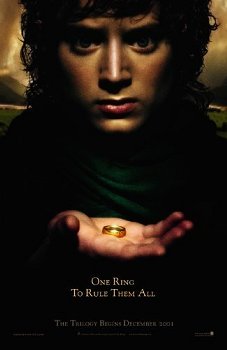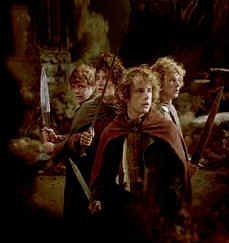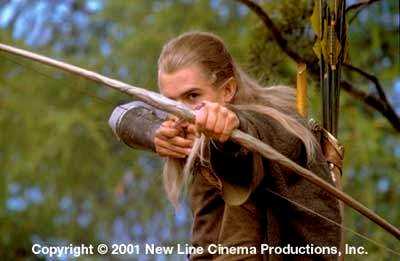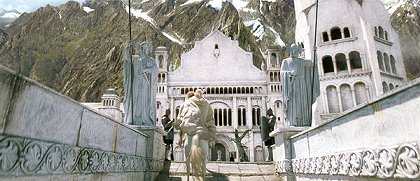The Mythical Journey
When thinking about the spirituality of The Lord of the Rings, it’s important to keep in mind that Tolkien explicitly stated it is not an allegory, a story with a unequivocal symbolic meaning. Rather, LOTR is a myth, a story with a wealth of symbols, more of a flashlight than a map. Here are some of my thoughts about some of its key symbols, and their significance for those on the mystical path.
Above all else, LOTR is a story about the journey. Our journey is filled with grace, light, peace, and hope—the spiritual path is easy—(except for when it’s not). The Lord of the Rings presents the path as shared struggle. It’s a trek from the blissful, peaceful land called The Shire (symbolic of our home in God) to battle the forces (mostly spiritual) which are seeking to dominate Middle Earth with their lust for power.
Here, absolute power can be gained through the One Ring. This ring has its roots in Plato’s Republic, which describes a ring that could be used to render the wearer invisible and visible at will. Boromir, a prince of Middle Earth, who repeatedly becomes seduced by the Ring’s strange temptation, shows the particular situation of leaders regarding power. The temptation is to think that with more power, more good can be accomplished. But history shows that fighting wars to exert power over an enemy seldom leads to lasting peace. No exertion of power can change the spirit. Plato and Tolkien both came to the conclusion that the Ring’s power would certainly be used for evil, corrupting even the best people despite their initial intentions, and so the wisest of the free peoples of Middle Earth refuse the Ring.
But the question remains “is there something wrong with power itself?” After all, can’t power be used for good? Certainly, but the ego wants power to change things to suit itself, catering to its fears, attachments, pride, and indifference to the spirit and the needs of the world. True spiritual power comes from humility, which is to say, by not seeking it at all. More than most tales, LOTR depicts the internal part of the struggle as well as the external—Frodo’s struggle is less against those who are trying to seize the Ring, and more against his own weakness against temptation. Our journey is a struggle to overcome our own ego, with its desire for power and control.
Another compelling symbol is the hero. It isn’t an immortal elf-lord who must destroy the Ring, but a frightened, mortal, little hobbit. And in our lives, instead of waving his hand over the earth and vanquishing sin and temptation, God entrusts us frightened, mortal, little creatures to be her hands and feet in the world, and build the Kingdom of love. And through it all, we must consistently refuse the temptation to build this Kingdom by force. The Kingdom of God is love, and comes only through Kingdom living, living by love.
Another question that comes up frequently is if there is a Christ figure in LOTR. The simple answer is no, there are several Christ figures in LOTR. Arwen prays that all of the grace she has may go to healing another. Like Christ, Gandalf and Aragorn make sacrifice themselves to help his friends, while battling the forces of darkness. And Frodo follows a call away from a pleasant life at home into danger and ever-greater suffering on behalf of the Shire and Middle-Earth. It is a deep teaching of Christianity that although there is one Lord, there are many Christs.
Great myths to continue to speak to us in changing ways even in changing circumstances. What is the Ring I’m carrying? Who are my friends in the Fellowship? Am I willing to “unmake” the Ring by surrendering my ego?
The epic
Every twenty years or so, an epic movie or series comes along that inspires a generation. I’m thinking of Gone with the Wind in the ’30s, Ben-Hur in the ’50s, the first Star Wars trilogy in the late ’70s and early ’80s, and now the Lord of the Rings at the beginning of the 21st century. It is that good. The script (by Philippa Boyens, Fran Walsh, and director Peter Jackson) took what must be some of the most intimidating material there is, and interprets it brilliantly. Jackson avoids the mistake Chris Columbus made with the first two Harry Potter films of filming whole scenes literally, and instead reshapes the whole vast arc of the myth into a moving and exciting drama, comprehensible for a newcomer to the tale, while not compromising the sense of the richness of Middle-Earth lore.
What is most impressive is that Jackson’s Lord of the Rings not only succeeds, but in my mind surpasses Tolkien’s masterwork. Whereas Tolkien could be somewhat impersonal and meandering, Jackson makes this a compelling character-driven saga with a brilliant sense of dramatic pacing. There is less of “the Road going ever on and on,” and more of a band of very vulnerable and fallible people weighted by a terrible mission. The sense of the Ring’s sheer evil, and the irresistibility of its temptation is brought home far more powerfully than in the book. So is the tragedy of the sacrifices that the characters are called upon to make: Bilbo’s sorrow for leaving and burdening Frodo with the Ring’s evil; Gandalf, like Christ, laying down his life for his friends, and perhaps most of all, Boromir’s death in battle, which seldom leaves a dry eye in the theater.
In fact, every change that Jackson makes seems to be a change for the better—when Frodo is wounded, we know the extent of his danger, and the suspense is powerful somehow even on the third viewing. In the book, he just seemed to be vaguely ill, and only after he was completely healed, was the true danger he was in revealed offhandedly. The pacing and dramatic logic is vastly superior. In the book, seventeen years(!) elapse before Gandalf returns to tell Frodo that the Ring must leave the Shire immediately. Much more logically, the film has Gandalf rushing back after a brief, single-pointed mission to research the truth of the One Ring, a focus on immediacy and urgency that permeates the film. There is also an omniscient point-of-view now, which allows cross-cutting between the Fellowship and Saruman.
Language and dialogue are also more natural. Few lines come from the book unaltered, so middle-class hobbits and warrior men no longer sound like British professors. The Elvish language of Sindarin is used subtly and beautifully in those communities. Aragorn and Arwen make their tryst speaking in the beautiful language of the elves.
In the book, battle was usually described in one or two undramatic paragraphs. Not so here. Although there’s no gore, battle is awful and terrifying, a manifestation of the evil that has infected the world, as indeed it is in our world as well. There are no cheery Star Wars-like dogfights on the Death Star here. Warriors are brave because they have the resolve to face their fear, not because they’re nonchalant or reckless.
And there is beauty. I’d say LOTR is worth seeing at full price simply for the majestic New Zealand scenery alone—fjords, meadows, rivers, and breathtaking mountains. The warm hominess of the Shire is so pleasant that you can easily understand why hobbits are loath to leave their beautiful country. And the elegance of Rivendell and the haunting radiance of Lothlorien at night are superb, reminiscent of the artwork of Arthur Rackham in his Wagnerian Ring cycle illustrations.
The casting is perfect. Elijah Wood’s strangely huge eyes perfectly express the awful sense of burden and fear that Frodo carries. Ian McKellen brings Gandalf’s heart and wisdom to life. Billy Boyd plays Pippin as the center of the comic relief with a charming naivety. Ian Holm brings forth Bilbo as the curmudgeonly but deeply loving old man who’s pondering the meaning of his life as he nears its end. Orlando Bloom plays the elf Legolas with an constant and unselfconscious dignity and grace that befits the immortal race of Middle Earth, and Liv Tyler presents Lady Arwen with power, tenderness, love, and beauty.
The photography is awesome. Most amazing of all is that the hobbits—all played by fully grown men—never seem to be over four feet tall, whether they are sitting, walking, or standing, alone or with humans, or the even taller elves. Throughout, close-ups and long shots are used ingeniously to involve us with the characters in their quest. Effects donot overwhelm this story—they serve it, brilliantly and judiciously—the emphasis is always upon the characters.
It is reported that at the end of his life, St. Thomas Aquinas said, “All that I have written is but straw compared to that which I have seen.” I believe Tolkien might have felt the same way about the massive mythical world that dominated his creative life. Thanks to Peter Jackson and the thousands of others who partook in this effort, I think we can come closer to seeing what Tolkien saw.Movie stills © 2001 New Line Cinema Productions Inc.






